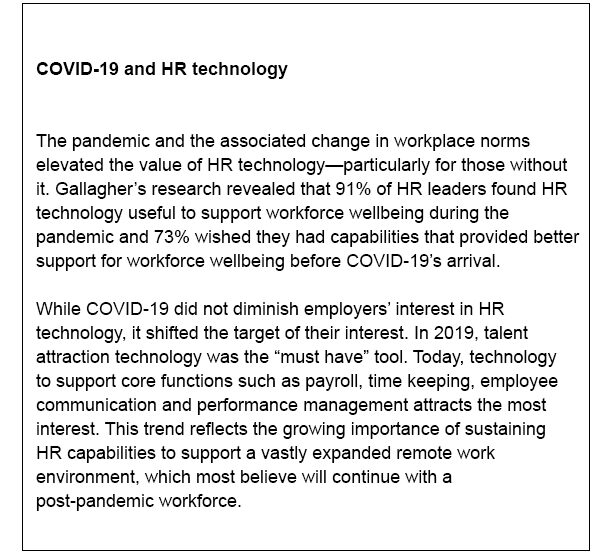With nearly 20 years’ experience in helping employers strategize, buy, implement and optimize HR technology, our organization is confident in our instinct about what’s happening in the market today and where it’s headed. But we’re also firm believers in using research to confirm (or correct) our thinking about employers’ adoption and use of HR technology.
Market research survey findings will differ, depending on who answers the questions. Most often, findings from broad-spectrum surveys are based on responses from large employer organizations, perhaps simply because they have a bigger pool of people to whom they can assign the task of completing the survey. The result is that small and mid-size businesses (SMBs) are often underrepresented in marketplace research and demographic breakouts by size may be skewed so that the definition of “small” is, surprisingly, large. While the standard for “small” and “mid-size” can vary, for the purpose of HR/employer group matters, most typically a group of less than 100 employees is considered “small” and 100 to 999 employees is “mid-size.”
SMBs make up the vast majority of U.S. businesses—99.9%, according to the U.S. Small Business Administration, and represent half (49.2%) of private sector employees. Many of these organizations lack a fulltime HR manager. A 2016 ADP study found that 70% of organizations with fewer than 50 employees assign HR responsibilities to individuals who have other significant responsibilities and little or no experience in workforce issues.
Even small companies with a dedicated HR professional are not exempt from challenges associated with limited HR resources. One- or two-person HR departments have little time for strategic activities as the core aspects of HR fully occupies their time. The narrower focus doesn’t mean they don’t use or need HR technology, however. SMBs have unique HR technology needs. Yet with more constrained resources (budget and staff) for investing in and optimizing HR technology, SMBs often rely on marketplace research to guide their decision making.
What the surveys say about HR technology purchases in 2021
In October, Gallagher released the findings from its 2020 HR Technology Pulse Survey, following on the heels of its annual Benefits Strategy & Benchmarking Survey (September 2020). According to Gallagher’s research, U.S. employers continued to invest—and invest more—in HR technology despite economic uncertainties stemming from the COVID-19 pandemic. Close to three-quarters (69%) of employers said they expect this trend to continue through 2021. However, what they invest in is changing (see sidebar).
Other surveys are predicting decreases in overall spending, but we believe this could stem from the definition of employer size. Gallagher’s survey categorizes SMBs in three groups: under 100, 100 to 499 and 500 to 999, whereas other industry surveys define SMBs as up to 10,000 employees. All research should be reviewed for its demographics data.
SMBs fail to take advantage of their HR technology investments
My team was not surprised by the growing level of investment in HR technology by small- and mid-size organizations. Through daily conversations with market stakeholders, we see first-hand how employers’ interest in HR tech applications drives market growth and the introduction of innovative new tools. Small companies invest more because they are still getting over the hump of automation and compliance—functionality that bigger organizations have largely addressed. Further, despite the economic uncertainty associated with COVID-19, the pandemic created new and heightened needs to effectively manage the organization’s people strategy with limited in-person contact. Technology was the obvious solution.
The Gallagher HR Technology Pulse Survey suggests, however, that many employers are not taking strategic advantage of available HR technology, nor of the capabilities provided by existing tools. Of the investments in HR tech made in the past two years, 82% of those were in technology designed to automate processes, versus technology that support more strategic activities such as enabling the organization’s human capital strategy (51%). The market solved for automation years ago, but employers—especially those with less than 500 employees—have been slow to catch up. SMB employers need to look beyond automation and focus on how new or optimized existing technology can support their people strategy and deliver on big organizational goals.
How SMBs can get the most bang for their buck
Whether organizations use HR technology to support core functions such as payroll or more strategic ones such as productivity, it is important to get the most out of the investment. This is especially true for SMBs with greater budget constraints than their larger counterparts. The Gallagher HR Technology Pulse Survey found that only 29% of employers use more than 75% of their HR tech capabilities and 40% use 50% or less. The root cause cited for underuse of available capabilities was a lack of adequate processes for optimizing these tools to support the organization’s people strategy. Half (50.3%) of SMBs had no process in place for this.
The fast pace of innovation in the HR tech industry partly explains the lag in optimization. However, optimization is just one factor. SMBs often purchase more tech than they need. In the absence of a guiding strategy, it’s easy to be distracted by the bells and whistles associated with an all-in-one HCM platform, when most SMBs don’t need (or will never use) some of this functionality.
Another barrier to optimizing HR technology is the use of a “legacy system” (applications relating to an outdated computer system), either on-premise or cloud-based. HR may have no awareness of how far the technology has evolved because they haven’t shopped around—some for 10 years or more. While on-premise platforms are a dying breed, getting the most out of cloud-based technology requires someone to pay attention to the regular update releases to decide what is useful (or not) to the organization. This is a luxury of staff resources that many smaller organizations don’t have.
We recommend small organizations invest in a “scaled back” HCM platform or take a build-your-own approach by buying a base HR platform and adding point solutions available from the provider’s technology marketplace to expand capabilities. Many point solutions (especially benefits-related) deliver better functionality than that which comes with an all-in-one platform. With either approach, it’s important to first understand the scope of available tools and then to consider how each can support the organization’s people strategy before making a purchase decision.
Tips for interpreting the research and other market data
The level of HR resources for small and mid-size businesses is not likely to increase anytime soon. If anything, resources will continue to tighten, forcing organizations to rely more heavily on external sources of information to support HR technology purchasing decisions. Following are tips to help SMBs be smart about interpreting market research findings (and other data) and using it to guide purchasing decisions.
- Seek out independent sources of market data. Independent research usually comes from companies that are not trying to sell the reader software.
- Look for survey demographics that “look” like your organization. Go to the methodology section of the report to understand the respondent profile (size, industry, geography). If organizations of your size and type are not represented, look elsewhere or review the findings “with a grain of salt.”
- Be mindful of online comparison tools. Everyone loves side-by-side product comparisons because it takes the hard work out of the shopping process. While these tools may seem a great time-saver, the goal of most is lead generation for participating companies. Be prepared for an onslaught of marketing.
- Use your network to compare needs and identify likely best-fit tools. Ask groups of similar size and industry about their preferred HR technology tools. The importance of size is well-covered in this article, but industry is also important. For example, industries that rely on shift, seasonal and/or hourly workers have unique timekeeping needs. Geography can also be a factor. For example, leave laws that impact HR tech functionality can vary at both the state and metropolitan level.
- Talk to your trusted advisor. Whether a risk manager, insurance advisor or industry consultant, third-party insight and expertise can provide an unbiased perspective to point you in the right direction.
Small and mid-size HR leaders make decisions every day about the investment in and use of HR technology tools. Lacking resources and expertise, however, many must rely on industry research to guide their planning and purchases. Yet few consider that the findings (and recommendations!) stem from research based on much larger organizations. The result can be poor (and costly) decisions that can’t easily be reversed. Understanding the source and methodology behind market research will inform the decision-making process and help to ensure that investments in new HR technology (or optimization of existing tools) will support organizational strategy and deliver a big win for a small HR department.


